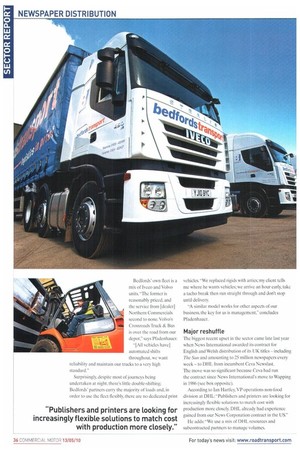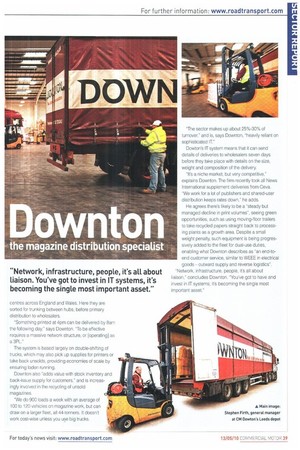Last winter, there were times when just about everything stopped except delivery of the daily papers.
Page 35

Page 36

Page 38

Page 39

If you've noticed an error in this article please click here to report it so we can fix it.
Despite the long-predicted demise of the printed word, a healthy if very slowly declining-demand for the road transport delivery of finished print product remains a substantial revenue source.
Within this specialist market sector, the most timesensitive consignment of all is your daily paper. Nobody wants late news, and typical delivery windows are less than six overnight hours for a short-life product.
Print logistics is a tough area to break into: large volumes make capacity, geographical coverage and close partnership working with the client essential, and the latter can't afford to associate with anyone not having a proven track record.
Magazine delivery, including Sunday supplements, is also time sensitive and not as straightforward as it might first appear, but offers greater opportunities to add value such as break bulk, consignment packaging and back-issue fulfilment.
New to the scene
Ceva Newsfast (the former TNT Newsfast business) has long been a major player in the UK newspaper delivery; however, publishers recently opened the market to Leeds-based Bedfords Transport. who picked up the Associated Newspapers ( The Daily Mail and Mail on Sunday) contract, and DHL, which re-entered the sector on the back of a contract win with News International.
Stef Pfadenhauer, MD of Leeds-based Bedfords Transport, points out the firm wasn't new to print, having delivered Associated Newspapers' colour supplements for the past 28 years. The company's approach to this turnover contract has been to work as a 3PL provider, using 23 subcontractors spread throughout the country. This provides nationwide coverage and allows Bedfords to speedily call on extra resources without needing its own infrastructure.
Throughout the cold snap. Bedfords managed 600 deliveries a day; at one point its East Midlands subcontractor Li Taylor Transport was ferrying drivers to work in 4x4s, but still the trucks got through, from print plant to regional wholesalers. "We did 50 loads on Christmas night and 426 runs between Christmas and New Year," recalls MD Alan Taylor, with justifiable pride.
Pfadenhauer claims an empathy with the cashflow needs of the small hauliers that work for him, aiming to pay invoices "within 30-45 days We want to work in partnership". Many had already worked for Ceva and DHL in the past and bought valuable experience to the job.
Bedfords' own drivers and its subbies are required to use hand-held tracking devices providing real-time monitoring of collections and deliveries; additionally, drivers must ring in to the co-ordinating office when arriving and leaving.
"The product is not barcoded, so we rely on drivers' discipline and initiative," says Pfadenhauer.
"Subbies have to stick to our rules," he continues, explaining the contract's clear chain of command and accountability. "They work first for Bedfords and The Daily Mail, this is dedicated contract time." Bedfords' own fleet is a mix of Iveco and Volvo units. "The former is reasonably priced, and the service from [dealer] Northern Commercials second to none. Volvo's Crossroads Truck & Bus is over the road from our depot," says Pfadenhauer.
"[All vehicles have] automated shifts throughout, we want reliability and maintain our trucks to a very high standard."
Surprisingly, despite most of journeys being undertaken at night, there's little double-shifting; Bedfords" partners carry the majority of loads and, in order to use the fleet flexibly, there are no dedicated print vehicles. "We replaced rigids with artics; my client tells me where he wants vehicles; we arrive an hour early, take a tacho break then run straight through and don't stop until delivery.
-A similar model works for other aspects of our business, the key for us is management." concludes Pfadenhauer.
Major reshuffle
The biggest recent upset in the sector came late last year when News International awarded its contract for English and Welsh distribution of its UK titles including The Sun and amounting to 25 million newspapers every week to DHL from incumbent Celia Newsfast. The move was so significant because Ceva had run the contract since News International's move to Wapping in 1986 (see box opposite).
According to Ian Hartley, VP operations non-food division at DHL: "Publishers and printers are looking for increasingly flexible solutions to match cost with production more closely. DHL already had experience gained from our News Corporation contract in the US."
He adds: -We use a mix of DHL resources and subcontracted partners to manage volumes. -"There are no dedicated or liveried trucks employed for print-sector contracts, which is one of the ways that DHL is able to offer very cost-effective and responsive supply chain solutions."
DHL uses a mix of in-house and subcontracted resources according to the area or volume to he distributed daily or weekly on a pay-as-you-go basis, and therefore the client only pays for the routes, hours, and the vehicles that it uses. Running from News International's print locations, the contract employs between 60 and 100 drivers and a similar number of vehicles can be involved.
However, this depends on print volumes, which are heaviest over the weekends or during high-.profile events such as the World Cup. says Hartley.
Vehicles are also double-shifted to boost efficiency. The overall operation is managed from a single transport control tower based at a DHL site in North London (Edmonton) close to the main News International print centre at Broxbourne.
This helps DHL to ensure service levels are maintained across the distribution network — critical when delivering products of such a Lime-sensitive nature. It also enables printing to continue until 11:30pm at night so that late evening news such as the final football scores can be included. E The dominant force in magazine distribution, with more than 65% of the market, is CM Downton — previously running under the Fastmag banner, now integrated into Downton's general operation — the people who deliver your CM (and sister titles Motor Transport and Truck & Driver) from pnnter to regional wholesaler.
Andrew Downton — who runs the family firm founded by his father, Conrad, with his brothers, Richard and John — has seen considerable consolidation in printers and newstrade suppliers. Whereas papers are printed and delivered between 10pm and 7am, magazines take "a very different route to marker', says Downton, and lead-in times vary greatly. Some monthlies may be printed up to 10 days before, and grouping and consolidating some 2,000 titles for precise delivery is "Downton's forte".
What Ceva, Bedfords and DHL are to national daily newspapers, Downton is to magazine logistics and its clients include IPC, Marketforce and Future Publishing.
In order to ensure your favoutire magazine is in the shops on the expected clay, vehicles from Downton's 350-strong fleet collect titles from printers and deliver to the nearest in a network of consolidation
centres across England and Wales. Here they are sorted for trunking between hubs, before prmary dstribution to wholesalers.
"Something printed at 4pm can be delivered by Barn the following day," says Downton. "To be effective requires a massive network structure, or [operating] as a 3PL."
The system is based largely on double-shifting of trucks, which may also pick up supplies for printers or take back unsolds, providing economies of scale by ensuring laden running.
Downton also "adds value with stock inventory and back-issue supply for customers," and isincreasingly involved in the recycling of unsold magazines.
"We do 900 loads a week with an average of 100 to 120 vehicles on magazine work, but can draw on a larger fleet, all 44-tonners. It doesn't work cost-wise unless you use big trucks. "The sector makes up about 25%-30% of turnover" and is, says Downton, "heavily reliant on sophisticated IT" Dowton's IT system means that it can send details of deliveries to wholesalers seven days before they take place with details on the size, weight and composition of the delivery.
"It's a niche market, but very competitive," explains Downton. The firm recently took all News International supplement deliveries from Ceva. "We work for a lot of publishers and shared-user distribution keeps rates down," he adds.
He agrees there's likely to be a 'steady but managed decline in print volumes", seeing green opportunities, such as using moving-floor trailers to take recycled papers straight back to processing plants as a growth area. Despite a small weight penalty, such equipment is being progressively added to the fleet for dual-use duties, enabling what Downton describes as "an end-toend customer service, similar to WEEE in electrical goods outward supply and reverse logistics".
"Network, infrastructure, people, it's all about liaison," concludes Downton. "You've got to have and invest in IT systems; Ts becoming the single most important asset."
































































































































